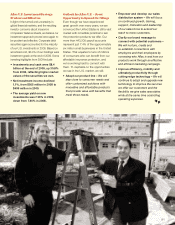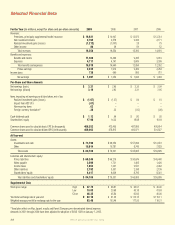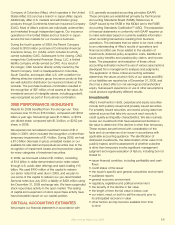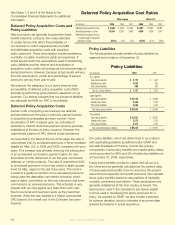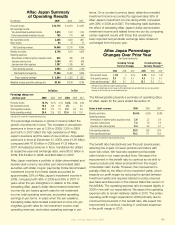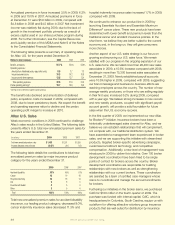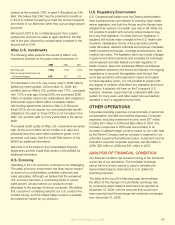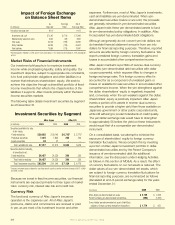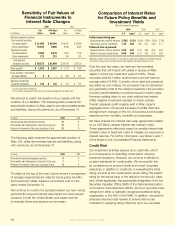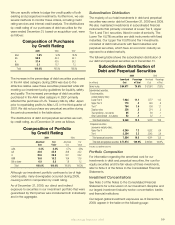Aflac 2009 Annual Report Download - page 33
Download and view the complete annual report
Please find page 33 of the 2009 Aflac annual report below. You can navigate through the pages in the report by either clicking on the pages listed below, or by using the keyword search tool below to find specific information within the annual report.
Samurai and Uridashi notes. ASC 815, “Derivatives and
Hedging,” requires that the change in the fair value of the
interest rate component of the cross-currency swaps,
which does not qualify for hedge accounting, be reected
in net earnings. This change in fair value was determined by
relative dollar and yen interest rates and had no cash impact
on our results of operations. At maturity, the fair value
equaled initial contract fair value, and the cumulative impact
of gains and losses from the changes in fair value of the
interest component was zero. We demonstrated the ability
and intent to retain the cross-currency swaps until they
expired in April 2009. The impact from ASC 815 includes
the change in fair value of the interest rate component of
the cross-currency swaps, which did not qualify for hedge
accounting, and is included in other income.
We have issued yen-denominated Samurai and Uridashi
notes and have entered into two yen-denominated loans.
We have designated these notes and loans as a hedge of
our investment in Aac Japan. If the value of these yen-
denominated notes exceeds our investment in Aac Japan,
we would be required to recognize the foreign currency
effect on the excess in net earnings (other income). The
foreign currency gain or loss on the excess liabilities
would be included in the impact from ASC 815. When
we made our hedge designations at the beginning of the
second quarter of 2009, the notional amount of our yen-
denominated liabilities exceeded our yen net asset position
in Aac Japan. Therefore, we de-designated this excess
portion of our yen-denominated liabilities from our net
investment hedge. An immaterial loss was recorded in net
earnings (other income) and included in the impact from
ASC 815 during the quarter ended June 30, 2009, as a
result of the negative foreign currency effect on the portion
of our yen-denominated liabilities that was not designated
as a hedge of our investment in Aac Japan. When we
reassessed our hedge designations at the beginning of
the third and fourth quarters of 2009, our yen net asset
position in Aac Japan exceeded our total yen-denominated
liabilities; therefore, all of these liabilities were designated as
a hedge of our net investment in Aac Japan, resulting in no
impact on net earnings during the third and fourth quarters
of 2009. Our net investment hedge was effective during the
years ended December 31, 2008, and 2007; therefore, there
was no impact on net earnings during those periods.
We have interest rate swap agreements related to the
¥20 billion variable interest rate Uridashi notes and have
designated the swap agreements as a hedge of the
variability of the debt cash ows. The notional amounts
and terms of the swaps match the principal amount and
terms of the variable interest rate Uridashi notes, and the
swaps had no value at inception. GAAP requires that the
change in the fair value of the swap contracts be recorded
in other comprehensive income so long as the hedge is
deemed effective. Any ineffectiveness would be recognized
in net earnings (other income) and would be included in the
impact from ASC 815. These hedges were effective during
the three-year period ended December 31, 2009; therefore,
there was no impact on net earnings. See Notes 1, 4 and
7 of the Notes to the Consolidated Financial Statements for
additional information.
Debt Extinguishment
During the rst six months of 2009, we extinguished
portions of our yen-denominated Uridashi and Samurai
debt by buying the notes on the open market. We realized
a total gain from extinguishment of debt of ¥1.6 billion, or
$17 million ($11 million after-tax), which we included in other
income. We did not extinguish any debt during the second
half of 2009.
Foreign Currency Translation
Aac Japan’s premiums and most of its investment income
are received in yen. Claims and expenses are paid in yen,
and we primarily purchase yen-denominated assets to
support yen-denominated policy liabilities. These and other
yen-denominated nancial statement items are translated
into dollars for nancial reporting purposes. We translate
Aac Japan’s yen-denominated income statement into
dollars using an average exchange rate for the reporting
period, and we translate its yen-denominated balance sheet
using the exchange rate at the end of the period. However,
it is important to distinguish between translating and
converting foreign currency. Except for a limited number of
transactions, we do not actually convert yen into dollars.
Due to the size of Aac Japan, where our functional
currency is the Japanese yen, uctuations in the yen/dollar
exchange rate can have a signicant effect on our reported
results. In periods when the yen weakens, translating yen
into dollars results in fewer dollars being reported. When
the yen strengthens, translating yen into dollars results in
more dollars being reported. Consequently, yen weakening
has the effect of suppressing current year results in relation
to the prior year, while yen strengthening has the effect
of magnifying current year results in relation to the prior
year. As a result, we view foreign currency translation as
a nancial reporting issue for Aac and not an economic
event to our Company or shareholders. Because changes
in exchange rates distort the growth rates of our operations,
management evaluates Aac’s nancial performance
excluding the impact of foreign currency translation.
Income Taxes
Our combined U.S. and Japanese effective income tax rate
on pretax earnings was 33.0% in 2009, 34.5% in 2008 and
34.6% in 2007. The effective tax rate declined in 2009 due
Aflac Annual Report for 2009 29




